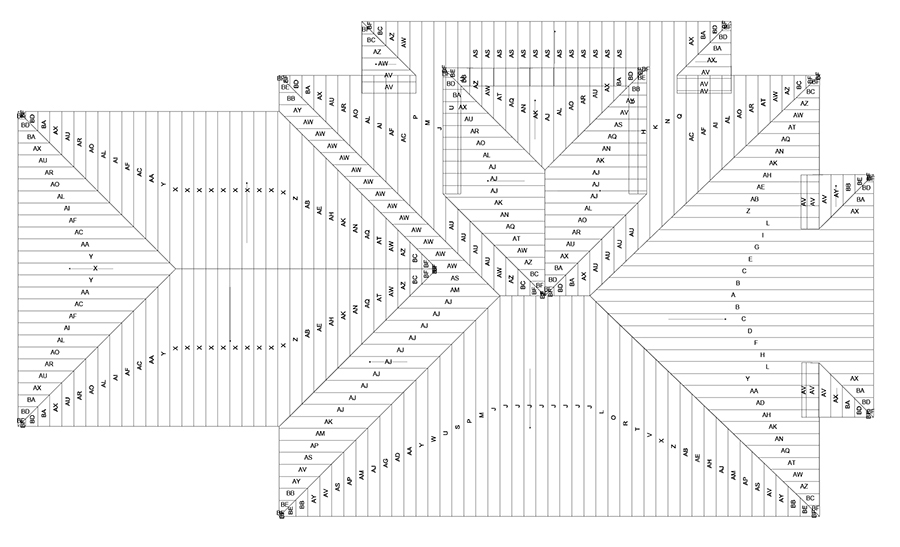
Why Extreme Metal Fabricators is your Metal Fabrication partner...
Extreme Metal Fabricators staff offers customer service rarely seen in the industry. We're not just metal craftsman, many of us are roofers. We have the experience of installing large complex residential roofs, as well as the Southeast's largest commercial installations.
We are here to assist you in sizing and ordering your job. Because of our extensive industry knowledge and experience we don't hesitate to offer you better alternatives in profiles, coating and installation procedures.
Extreme Metal Fabricators offer a wide range of metal roof systems to fit every roofing need. Masterfully crafted and easily modified for every unique project, our metal roof systems elevate design and deliver peak performance for optimum value. We offer the cutting edge of architectural design and customization with many appearances and styles. The beauty of our metal systems is unmatched.
CUT LIST EXAMPLES: Computerized Roof Panel Layout


METAL ROOFING BENEFITS:
Metal beats out conventional roofing materials on a number of different counts:
Expected life. Properly installed, a metal roof should last as long as the house, sealing out water, surviving high winds, and easily shedding snow. Metal is resistant to fire, mildew, insects, and rot. Warranties vary widely, but most companies back their products for 20 to 50 years. Paint finishes typically have a 30-year limited warranty.
Weight. Compared with tile at 750 pounds per square (an area equal to 100 square feet) or concrete tile at 900 pounds per square, metal roofing is lightweight. Most varieties run from 50 to 150 pounds per square.
Sheet-metal roofing is lightweight, fire-resistant, quick to install, and great at shedding water and snow.
Some types of metal roofing materials may be applied over an existing roof without the need for tear-off or additional structural support. In fact, if you’re building a house or an addition, you can often downsize or reduce the number of roof support members.
Speed & ease of roofing installation. Most metal roofing materials come in multiple-shingle sections or in 12- to 36-inch-wide panels. An accomplished contractor can install these quickly. If your roof is stripped off and a storm is on the way, shortening the process by a day or two may prove to be a critical advantage. Because of the material’s light weight, you can save on engineering and building the supporting structure.
Fire resistance. Because metal roofs are noncombustible, they’re given a Class A fire rating (the most resistant). Part of a roof’s classification depends on materials beneath the surface that could ignite in intense heat. Most metal roofs applied over a combustible material such as wood shingles have a lower, Class C rating.
Heat conduction. Metal reflects radiant heat from the sun, minimizing midday heat gain. This means you save energy needed for air conditioning during the day. Though the material itself is low in insulation R-value, many systems utilize a dead-air space between the metal and roof deck to increase energy efficiency.
Minimal roof pitch. Most metal roofing materials can be installed on gently pitched roofs without presenting a leaking potential. Minimum roof pitch is 3-in-12 (the roof rises 3 inches for each horizontal foot).
Maximum shedding of rain and snow. Metal roofing is practically impervious to rain and snow because of the way it is designed to interlock and because the surfaces are hard and slippery.
METAL ROOFING - Cool & Sustainable
Builders and architects are changing the way they select building materials and design for energy performance. The roof can have the greatest impact on the energy use of a building. Coatings and finishes available today qualify metal as a recognized cool roof product.
Buildings consume one-third of all energy and two-thirds of all electricity generated. Cool roofs can help reduce energy consumption by lowering cooling loads. Lightly colored, more reflective roofs save up to 40% in cooling energy, as reported by the Heat Island Group of Lawrence Berkeley National Laboratory.
Highly emissive roofs can lower urban air temperatures, thereby benefiting the environment by reducing smog formation. Metal roofing has many attractive features. Its architectural appeal, variety of profiles, textures and color, flexibility, and durability make it popular for residential and commercial projects, both in low-slope and steep-slope applications.
Metal roofing and its finishes are inert, safe materials that don’t pose a health risk. Metal roofing is tested for wind, fire, and hail resistance, and listed with various building codes and entities. Its non-combustibility can reduce the spread of fire in and among buildings.
The Florida Solar Energy Center found that metal roofing...
“...saves the most energy as a result of its high reflectance and superior ability
to cool quickly at night.”
Metal roofing was reported to save a Florida homeowner about 23% annually
in cooling costs, compared to a dark gray asphalt shingle roof.
ENERGY EFFICIENCY
A building’s cooling and heating costs can be effectively reduced by insulation under the roof surface. Adding increasing amounts of insulation is not always the best way to
save energy.
As part of total system design, a cool metal roof can be an economical method for better energy efficiency.
Cool metal roofing is available unpainted, with oven-baked paint finishes, or with granular-coated surfaces. This family of roofing can achieve solar reflectance of over 70 percent.
Reflected solar energy allows the roof surface to remain cooler, which means less heat is transferred into the building.
The infrared emittance of a roof is a measure of absorbed solar radiation that is reemitted from the roof surface to the sky.
Emittance of metal roofing varies with the surface finish. Emittance of painted or granular-coated metal roofing can be as high as 90 percent. Where annual cooling loads dominate, a
highly reflective and highly emissive painted or granularcoated metal roof is optimal for reducing energy consumption. Where annual heating loads dominate, an unpainted metal roof is more desirable because of its low infrared emittance.

All rights reserved | Extreme Metal Fabricators
Website by: Pharus Group LLC.